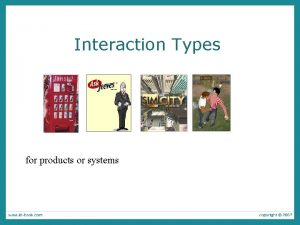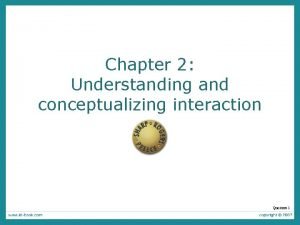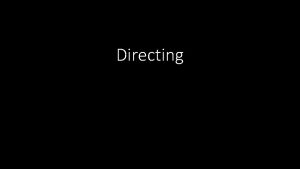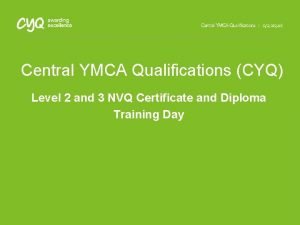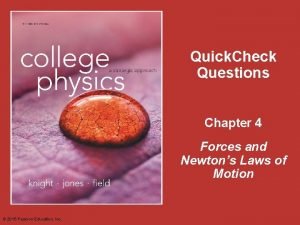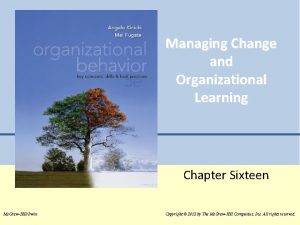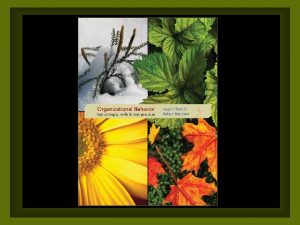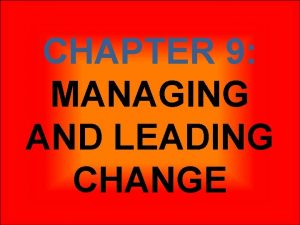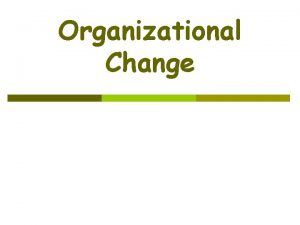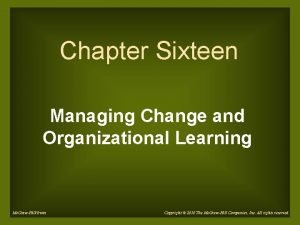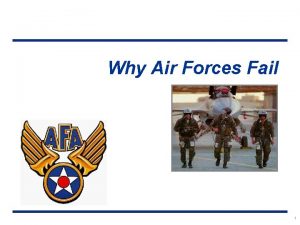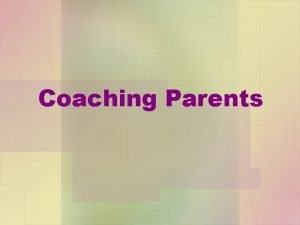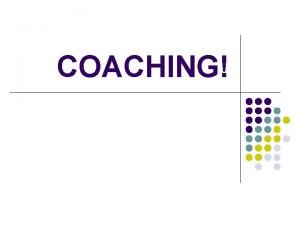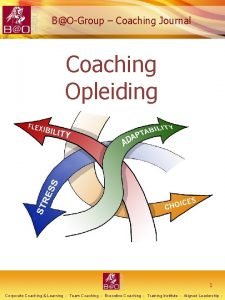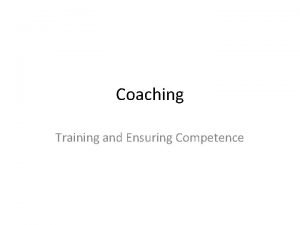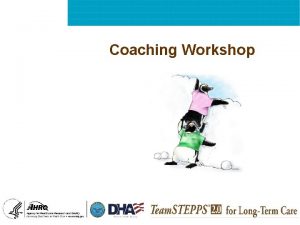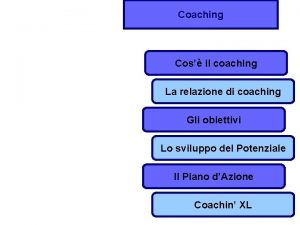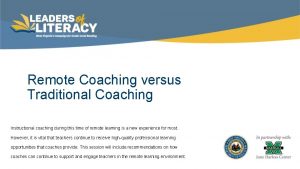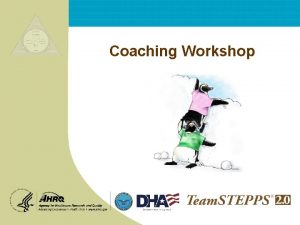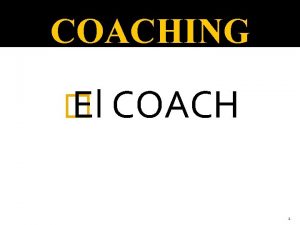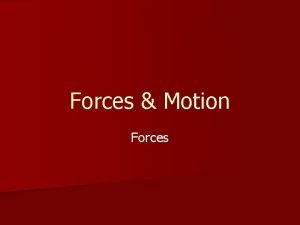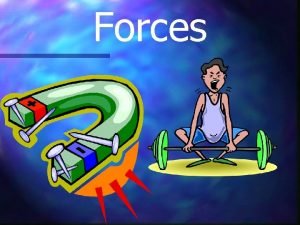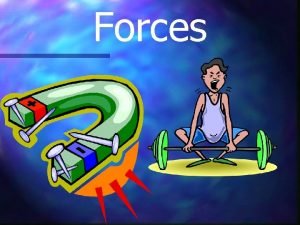Coaching Instructing Join Forces Change in the air













































- Slides: 45

Coaching & Instructing Join Forces Change in the air Thermalling Lookout Lead and Follow Method of thinking Don’t let pilots learn by themselves.

Nationally Coaches Experience Students were inherently safe pilots Could not thermal They were poor at lookout.

Change in the air Blending Coaching and Instruction Improve the efficiency of flying Greater effort on thermalling Glider Pilots Certificate = Independent operator

The Reason Behind Changes Fast track pilots to be able to soar well To maintain membership.

Thermalling Most students think that That the yaw string should be down the middle when. Xthermalling That they should thermal as slow as possible Do not understand the importance of angle of bank, or certainly can not fly at 45°.

Bank Put Straws or some bank indicator on the glider If we wish to bank accurately within a couple of degrees how can we do it without a guide? Why do they get taken off? .

Tiring Any early pilot becomes tired when cross country This is because once they are out on course they are over stressed thermalling Solo Students need to PRACTICE thermalling Give them a challenge “How many 1000 ft climbs in given time” Say 2 Hours Once practiced they will not be under so much stress once going x country.

Who Can Benefit? Potential Guns. Intermediate pilots Those who want to soar locally Never assume a local soarer does not have the potential to go X Country All pilots who would later find they are frustrated being a glider pilot and leave the sport.

Lookout When do we practice lookout How expensive is it to train when flying? Why not train on the ground My Nullabour experience Why not have a “lookout chair” Does your club want a chair if so I will arrange.

Visualisation Can be used for Pre take off Landing checks Modified Circuits Thermalling All aspects of flying.

Lead and Follow Can be dangerous! Is highly beneficial To a Pilot who has had enough of 2 seater The Pilot has achieved the flight Brings a close relationship with coach Needs detailed preparation.

Lead and Follow Preparation Needs detailed preparation Radio needs to be used a lot Take notes in flight to discuss later Can be done with 2 seater Is only beneficial if done with the right techniques.

Dangers. Double blind.

Dangers Cut Inside.

Dangers Approaching Thermal.

Dangers Keep at the same height as the student This is safer.

Theory To allow the student to see how it is done Perform the task in a single seater, although there is noting stopping a twin leading or following Student to see how to fly in pairs.

Key Skills Lookout Keep reasonable radio communication Joining up, the best is for the coach to launch first then join the student Where required the students job is to follow and see what is being done, not try to show the coach how to fly Pair thermalling Having their own cut off height and sticking to it.

Coaches No 1 Requirement The coach must stay at the same height as the student, this reduces anxiety and prevents the possibility of midair If the Coach is at an altitude other than that of the student they will be looking up at the coach and thus not see other aircraft at their height.

Pre Flight Check Getting Together – Brief on who pays for the coaches flight – Agree on a coaching frequency usually 122. 5 or 122. 9 – If there are 2 students agree which replies to coach first.

Pre Flight Check – The coach will launch first – Once the student is established in a thermal the coach will come down and thermal up – If there is a second student once the second student has launched and become established in a thermal the coach will come down leaving the first student to stay put even if thermal runs out, and wait for the coach to come up – If he does not then don’t waste your time with them – Once all are together and above CTAF the coach will say “Change frequency to channel 9” on the assumption that this is the agreed channel – The students will once changed channel say “GRB on Channel” where that is the glider call sign.

Pre Flight Check – When leaving thermal the coach will say on the last turn “Leaving at 80 knots” – Student will say “Following” – The coach will always come down to the level of the student, this is vital for both moral and safety. Do not leave students below you looking up at you – Do not cut inside other pilots.

Method of Thinking Howard Gardner Linguistic Logical / Mathematical Musical Visual / Spatial Bodily / Kinesthetic Intrapersonal Interpersonal Naturalist.

Linguistic – Talking – DVD – Books and written information/ notes – Theory based – Power point presentation (predominant text).

Logical / Mathematical – Mathematical and Graphs.

Musical – Link theory to music – Theory put into rhyme and rhythm.

Visual / Spatial – Images – Photos – Graphs – Videos.

Bodily / Kinesthetic – Action and demonstration.

Intrapersonal – Inward thinking.

Interpersonal – Socialising with other people.

Naturalist – Has an empathy with the environment – Sensitive to beliefs.

Let’s look at where we fit in.

So How do we teach Glider Pilots? Linguistic Logical / Mathematical Musical Visual / Spatial Bodily / Kinesthetic Intrapersonal Interpersonal Naturalist.

Linguistic – Put in touch with GFA Books – Guide to web sites GFA and – www. James Cooper. com. au – Rechman and Ecky.

Logical / Mathematical – Flight analysis and statistics – Drawings – Scientific approach like “lift & drag” – Communication White Board – Mathematical and Polar Curves.

Musical – Emphasis on flight noises – Hear thermal core – Tune aircraft attitude to achieve a certain “sound”.

Visual / Spatial – Observations in flight (visual) – Straw – Lead and follow – Photos of Clouds – White Board.

Bodily / Kinesthetic – Action and demonstration – Air time – Exercise in the air – Feel the lift – Kinesthetic observations (feel of stick, air etc. ).

Intrapersonal – Diary based analysis (Blue Book) – One on one coaching – Flight analysis – Homework exercises.

Interpersonal – Open questions – Group learning, communicate as part of the group – Team training – Make time to talk available – Verbal communication – Interactive style – Use humor, but make a firm stop to it (danger-/ attention-zone on the other side of the jokes).

Naturalist – At harmony with elements – Aim to point out the clues given by nature (like trigger points on the ground, cloud shapes, cloud forming, etc. ) – Coach in an outside environment rather than inside.

Train pilots for what they will do Don’t let Pilots teach themselves the more risky aspects of flying. Low level thermlling Low level finishes.

Let students do what they will do. Low level finish practice for comps Don’t turn back on the finish line Low thermalling but not in circuit But within their abilities, or what they will do anyway.

Perhaps the most important thing you can do Set an example Fly round the clubs Do big tasks They will copy you!.

 Interaction type
Interaction type Instructing conversing manipulating exploring
Instructing conversing manipulating exploring Soil seed and sower in health education
Soil seed and sower in health education Principles of directing in management
Principles of directing in management Cyq
Cyq Hubungan air dengan tanah
Hubungan air dengan tanah 2 examples of like parallel forces
2 examples of like parallel forces The forces shown above are
The forces shown above are Intermolecular vs intramolecular forces
Intermolecular vs intramolecular forces Similarities of intermolecular and intramolecular forces
Similarities of intermolecular and intramolecular forces Inter vs intramolecular forces
Inter vs intramolecular forces Force and motion
Force and motion Force examples in everyday life
Force examples in everyday life Is erosion constructive or destructive
Is erosion constructive or destructive 10 year old sarah stands on a skateboard
10 year old sarah stands on a skateboard Internal forces of change in an organization
Internal forces of change in an organization What are constructive forces
What are constructive forces Internal forces of change in an organization
Internal forces of change in an organization Internal forces of change in an organization
Internal forces of change in an organization Structural inertia resistance to change
Structural inertia resistance to change Force field theory
Force field theory Detecting evolutionary forces in language change
Detecting evolutionary forces in language change Which of the following forces motivated change at h&b
Which of the following forces motivated change at h&b Forces of change
Forces of change How do destructive forces change the land's surface
How do destructive forces change the land's surface Hát kết hợp bộ gõ cơ thể
Hát kết hợp bộ gõ cơ thể Frameset trong html5
Frameset trong html5 Bổ thể
Bổ thể Tỉ lệ cơ thể trẻ em
Tỉ lệ cơ thể trẻ em Gấu đi như thế nào
Gấu đi như thế nào Chụp phim tư thế worms-breton
Chụp phim tư thế worms-breton Hát lên người ơi alleluia
Hát lên người ơi alleluia Môn thể thao bắt đầu bằng từ đua
Môn thể thao bắt đầu bằng từ đua Thế nào là hệ số cao nhất
Thế nào là hệ số cao nhất Các châu lục và đại dương trên thế giới
Các châu lục và đại dương trên thế giới Cong thức tính động năng
Cong thức tính động năng Trời xanh đây là của chúng ta thể thơ
Trời xanh đây là của chúng ta thể thơ Mật thư tọa độ 5x5
Mật thư tọa độ 5x5 Phép trừ bù
Phép trừ bù độ dài liên kết
độ dài liên kết Các châu lục và đại dương trên thế giới
Các châu lục và đại dương trên thế giới Thể thơ truyền thống
Thể thơ truyền thống Quá trình desamine hóa có thể tạo ra
Quá trình desamine hóa có thể tạo ra Một số thể thơ truyền thống
Một số thể thơ truyền thống Cái miệng nó xinh thế
Cái miệng nó xinh thế Vẽ hình chiếu vuông góc của vật thể sau
Vẽ hình chiếu vuông góc của vật thể sau
